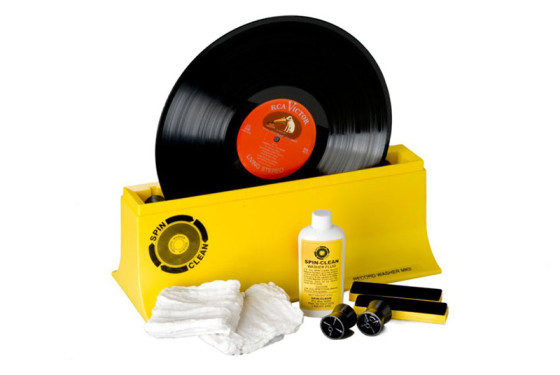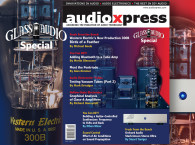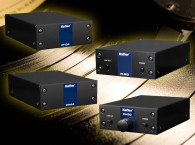First, a little history is necessary. Many record-cleaning devices have appeared over the years, especially since the advent of the microgroove LP, with which almost any dust is audible. I have not tried them all, but I have experimented with a few of them. My first gadget was the Dust Bug, made by Cecil E. Watts. It was a Plexiglass, tonearm-like device that had a cylindrical brush instead of a stylus.
The Dust Bug would capture the larger pieces of dust that were attracted to the LP. I also recall a simpler device — a soft pad covered in blue velvet — that attempted to get down into the grooves and brush out the dust, but it just pushed the dust around on the LP.

Record Preservation
In the mid-1970s, I attended a San Diego Audio Society meeting in San Diego, CA. The society hosted a talk by Dr. Bruce Maier, a chemist and the inventor of the Discwasher record-cleaning tools. The Discwasher consisted of a D3 (now D4) vinyl cleaning fluid and a walnut brush handle covered on one side by directed-pile velvet cloth. Mechanically, the velvet fibers would get into the LP grooves as long as the brush was properly oriented. When moistened with D3 fluid, the brush would pick up dust in spite of the electrostatic attraction, and the record would sound much cleaner.
Because drying strokes by the brush would recharge the static electricity on the LP, you could follow the cleaning by using a Zerostat antistatic gun to discharge the static. Both of these cleaning appliances still exist in one form or another. The Discwasher brand is now owned by another company, and reports of its brush quality on the Web are not flattering. I still use the Discwasher fluid.
During his talk, Maier discussed earlier products’ failure to properly clean records and he explained how he came up with his system, detailing his development of the cleaning formula. Of course, it is mostly water, but he added a detergent that removed dust and oily fingerprints from the record without “pulling” the lubricant component from the vinyl formulation. Eventually, he found a detergent that could do this, which he confirmed by testing the used cleaning solution for the presence of vinyl lubricants.
Because it really works, I have used the D4/Zerostat routine religiously when playing LPs, especially prior to transferring my best LPs to my computer for remastering in the digital domain. This is adequate for records I have purchased new and kept in good shape, but it is not trustworthy when I buy used records at shops or at library benefit sales. Here, you are taking your chances, and you might want to give your used finds a good cleaning before trusting them to an expensive stylus.
Times Have Changed
When I lived in San Diego, I would occasionally take a handful of used LPs to the local super-fi emporium, which would let me clean them myself on a Keith Monks record-cleaning machine for $0.50 per LP. This always made an audible difference in the LPs’ playback quality. However, I no longer live in San Diego, and it is a bit far out of my way to travel that distance simply to clean a new batch of old LPs. And I have a box of used library-sale LPs awaiting transfer to my hard drive. Serious collectors might spring for their own Keith Monks machine, or some other brand, but they are expensive and take up a lot of space.
The Spin-Clean System
Ed Dell lent me the Spin-Clean Record Washer System MKII for review. This cleaner consists of a cleaning fluid tank containing rollers and a pair of brushes (see Photo 1). You plunge your LP into the narrow space between the brushes, which are submerged by the cleaning fluid, and you rotate the disk by hand. The disk turns on rollers inserted into the tank (see Photo 2). You can adjust this unit to clean 12” disks, 78-rpm disks, and 45-rpm disks, simply by moving the rollers into corresponding slots in the tank. The disk will be supported with its label out of the fluid.
When you receive this device in its shipping box and read the instructions, you will need to accomplish some preliminary steps before the machine is ready for use. It comes with drying cloths that you must pre-launder before use. In addition, because most of the cleaning fluid consists of water, you will need to buy your own gallon of distilled water for filling the tank. After all, this is less expensive than shipping gallon jugs of water around the country.
To change the water into cleaning fluid, you add measured amounts of cleaner concentrate to it. A table explains how to do this, but it needs a bit of interpretation. The 4-oz. bottle of concentrate has a small cap, so you need to add three capfuls to a full cleaning tank. The larger size bottles have a larger cap, so you need to add only one capful to a full cleaning tank. The included instructions are explicit about how many turns to rotate the disk, and in which direction. They are equally explicit about which direction to wipe the disk with the drying cloth.
Practical Experience
When I cleaned a few test LPs for review, I worried that the drying cloths were not nappy enough to reach down into the grooves and pick up the liquid. But after I ran the cloth around the disk a few times, the record seemed to dry out in good shape. I expected to get a lot of fluid on my T-shirt and on the record label, but they both stayed dry with careful handling, which surprised me.
I used this machine to clean several LPs. For one LP, I did careful tests to see whether there was some objective measurement of cleaning effectiveness. One LP was a Musical Heritage Society recording of 12 Sonatas for Harpsichord by Domenico Scarlatti, MHS 555. These sonatas are quite lively, and the sound does not reveal any dust that might be present on the record, so I enlisted the aid of ClickRepair software by Dr. Brian Davies (www.clickrepair.net).
The first time I transferred Side 1 to my hard drive, I used only the Discwasher brush and Zerostat pistol as usual. (I did not want to risk my stylus with an untouched used LP.) Then I ran ClickRepair and wrote down the number of repaired samples divided by the total number of samples.
Next, I used the Spin-Clean system to clean and dry the LP. I let the LP airdry after using the drying cloth, just to be sure. I transferred Side 1 again after a quick touch-up with the Discwasher routine. Finally, I ran ClickRepair again to see whether the number of repaired samples had decreased, due, I hoped, to removal of dirt that would cause audible ticks. The final score was 1 out of every 326 samples repaired before cleaning, and 1 out of every 347 samples repaired after cleaning— both in the left channel. The right channel went from 1 out of every 305 to 1 out of every 318. This was a measurable improvement in both channels.
I am pretty sure the cleaning fluid removed dust the stylus would normally push out of the way in the groove during playback, and this would not register in ClickRepair. But this dust is abrasive to your stylus and to the vinyl grooves, so it is better to remove it. I have also cleaned some LPs using the Keith Monks’ machine to remove some sticky substance in the grooves, and I am sure the Spin-Clean machine would work as effectively.
If you were to engage in a mass record-cleaning effort, you would need a big supply of the drying cloths on hand, and you would want to hang them up to dry. They dry pretty fast on a coat hanger. Also, if you follow the drying cloth with air drying, you will need a rack or some support for your LPs. If you don’t have space for a bunch of air-drying LPs, this may limit the number of LPs you can treat at one time.

Give It A Spin
The Spin-Clean system works as advertised. It is an unpretentious, affordable product. It can be used to get more pleasure and lifetime out of your LPs, including some disks that may be irreplaceable. It is a little bit tricky to set up and you do all of the cleaning yourself, but there is no electric motor or other mechanism to fail. It won’t remove particles that are molded into the record as part of the vinyl formulation (which may contain label material from reground records), but it will remove loose particles that would otherwise cause wear.
The manufacturer does not make any claims one way or the other regarding whether the cleaning fluid is designed to discriminate between fingerprint oil and the vinyl lubricants. However, the fluid doesn’t have any obvious odor, particularly that of alcohol. aX
Spin-Clean International
P.O. Box 15200
Pittsburgh, PA 15237
(800) 931-5850
www.spincleanrecordwasher.com





